Types of Green Beetles (With Pictures) – Identification Guide
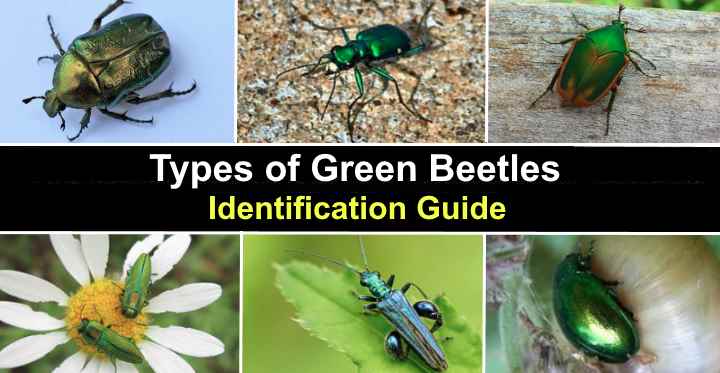
Green beetles are fascinating insects with smooth bodies, six legs, and two antennae. Some eye-catching green beetle varieties have shiny metallic green bodies and iridescent coloring. The most common beetle with a green body is the green June beetle (Cotinis nitida) which has a shiny green body with bronze patches on it. Although most beetles are relatively harmless, beetle larvae can sometimes damage turfgrass, ornamental plants, and even soft furnishing indoors.
Species of beetles belong to the phylum Arthropoda and the order Coleoptera. Like all insects, beetles have six legs, a three-part body consisting of a head, thorax, and abdomen, and two antennae. Many green beetles also have wings, and these are typically under their hardened wing cases called elytra.
Green beetles are typically small insects, with the smallest being around 0.15” (4 mm) and the largest being 2” (50 mm). The spectacular iridescent green colors on beetles like the mint leaf beetle or Japanese beetle make them easy to spot in a landscape. However, like the pale green weevil, other green beetles without a shiny green abdomen may be harder to identify in a garden because they blend in with green foliage.
This article is an identification guide to help spot the difference between various species of green beetles. In addition to pictures of green beetles, you’ll get helpful descriptions to help identify the green bug you found on plants or in your home.
Green Beetle Identification
Green beetles are identified by their green body, size, type of antennae — clubbed or serrated, pincers or mandibles near their mouth, and habitat. Up close, you can look for the two hard green wing covers, which means the wings won’t be visible. In some cases, its body shape makes the beetle species easy to identify.
Although many people refer to green, brown, or black beetles as bugs, they are not bugs in the scientific sense. True bugs are insects belonging to the order Hemiptera. You will notice that some green bugs like shield bugs or stink bugs look like pale green beetles. However, insects classified as true bugs don’t belong to the beetle order Coleoptera.
Types of Green Beetles (With Pictures) — Identification
Let’s look in detail at several varieties of green beetles, some of which have shiny metallic green bodies. In contrast, some have dull dark green wing cases.
Green June Beetle (Cotinis nitida)
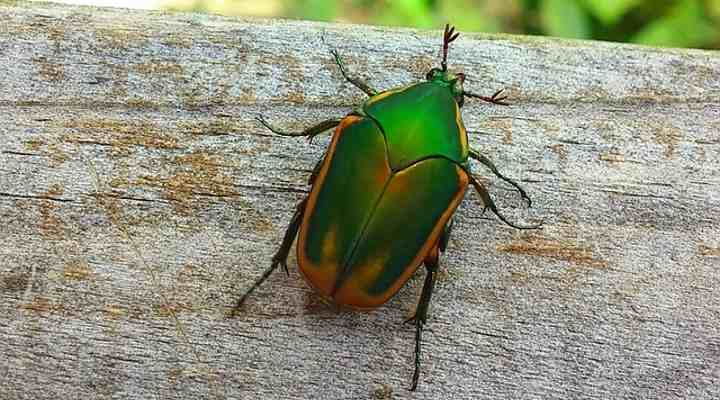
The green June beetle is identified by its bronze gold edges and antennae that split near the tip
Green June beetles are identified by their distinct emerald-green-colored body with golden bronze borders. The green beetles also have recognizable gold blushing on their elytra, iridescent green and brown underside, and green heads. You’ll also notice that the green insects have short, dark brown antennae that split near the tip.
Green June beetles are a variety of large beetle measuring 1” (25 mm) long and 0.5” (13 mm) broad. As their name suggests, these flying green beetles are active in midsummer. You will find the metallic green beetles feeding on fruit like apples, pears, peaches, plums, and nectarines. Because they especially like figs, they are sometimes called fig-eaters. However, the figeater beetle is a different but related species (Cotinis mutabilis).
Green June beetle larvae grow up to 2” (5 cm) long and are a creamy-whitish color. The fat, C-shaped grubs can sometimes damage lawns, turfgrass, and ornamental plants as they feed on roots.
Green beetle identification
Identifying features of the green June beetle are its velvety green body with dull bronze or gold edges and shading. The green beetles are commonly seen flying near the ground or crawling on plants in mid to late summer.
Green Fruit Beetle (Cotinis mutabilis)
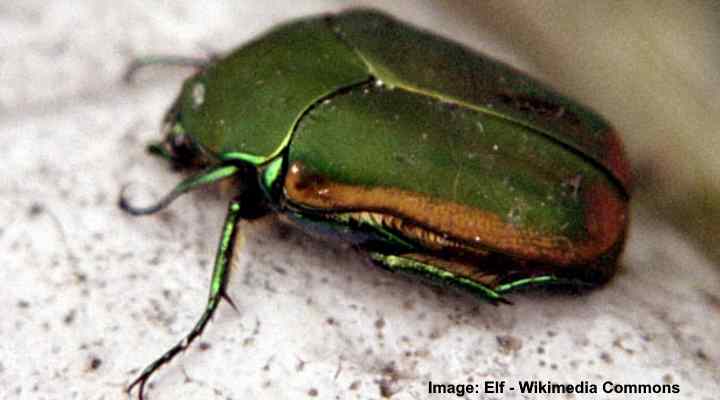
The green fruit beetle has a big metallic green body with bronze edges and clubbed antennae and is similar to the green June beetle
Also called the western green beetle or figeater beetle, the green fruit beetle is recognized by its metallic green oval body, clubbed antennae, and bronze color along the wing margins. Other identifying features of the green fruit beetle are its horn-like projection on its head, prominent legs, and large size.
The green fruit beetle can measure 0.75” to 1.3” (20 – 34 mm) long. You will often find the adult beetles feeding on sweet, soft-skinned fruits. Types of fruit figeater beetles feed on include grapes, peaches, pears, tomatoes, and figs. They are also attracted to fermenting or ripening fruit because of their sweetness.
One difference between green fruit beetles and June beetles is that their larvae don’t damage lawns. Therefore, green fruit beetles are only considered a minor nuisance in residential gardens rather than an invasive pest.
Green beetle identification
The green fruit beetle is a type of scarab beetle, identifiable by its dull, metallic green body, brilliant iridescent underside, and black, clubbed antennae.
Japanese Beetles (Popillia japonica)
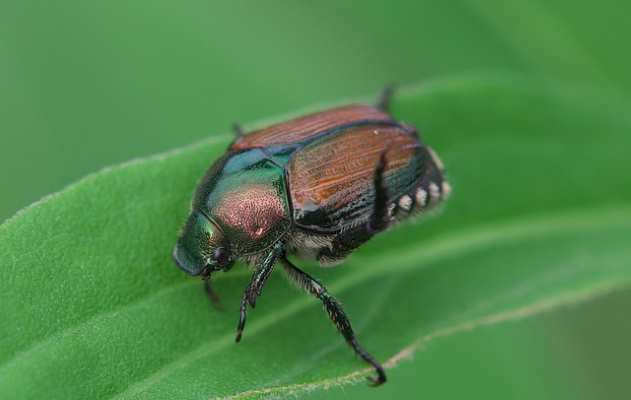
Japanese beetles have iridescent green and copper colors and white tufts on each side
The Japanese beetle is a shiny green beetle with an oval body with metallic green and coppery-bronze elytra. The easily identifiable feature of Japanese beetles is its distinctive five white tufts along the base of its abdomen. The white spots make the invasive Japanese beetle easy to tell apart from similar-looking June beetles.
The Japanese beetle measures 0.3” to 0.4” (8 – 11 mm) long and up to 0.27” (7 mm) wide. The iridescent green bugs do tremendous damage to lawns and tree and plant foliage. Adult Japanese beetles can skeletonize plant foliage in no time, making trees and shrubs appear unsightly. In addition, Japanese beetle larvae live in the soil, feeding on lawn grass roots.
Japanese beetles lay eggs in the soil where the larvae hatch and develop. Then when mature, Japanese beetles emerge from the ground to do their damage. Unfortunately, this beetle life cycle makes it difficult to eradicate Japanese beetles and prevent them from damaging your yard.
Green beetle identification
The Japanese beetle is easily identified by its shiny green and bronze abdomen, green thorax and head, and white tufts around its sides.
Green Tiger Beetle (Cicindela sexguttata)
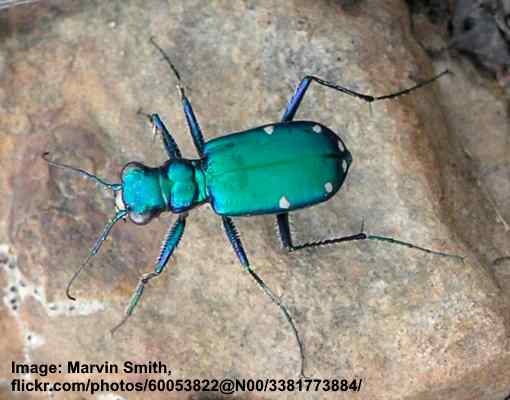
The iridescent green tiger beetle can be identified by its long legs and six white spots on its rear body
The green tiger beetle is a large beetle with a metallic-green body, long blue-green legs, and long, serrated antennae. The common green ground beetle is also called the six-spotted green tiger beetle due to the recognizable cream-colored spots on its elytra. Other identifying features are its long spindly legs and large mandibles.
The sizable, fast-moving shiny green tiger beetle grows up to 0.55” (14 mm). It is typically found in deciduous forests, feeding on small arthropods like caterpillars, spiders, and ants. Another behavioral habit of the green tiger beetle is its speed. It’s one of the fastest ground beetles and will fly if necessary.
Green beetle identification
The green tiger beetle is easily identified due to its shiny green body, relatively long legs, and pale cream-colored spots on its wing cases.
Tansy Beetle (Chrysolina graminis)
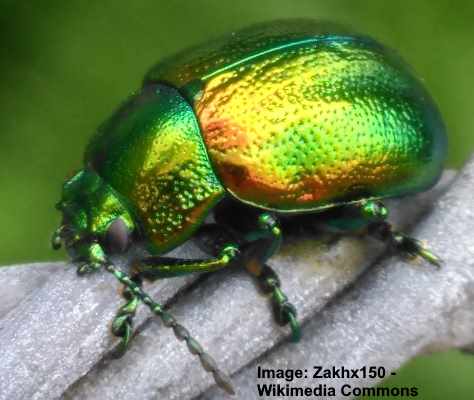
The metallic green and gold tansy beetle has a small rounded body with segmented antennae and short legs
The tansy beetle is an eye-catching beetle with an oval rounded body and distinctive bright metallic green and golden coloring. Additional identifiable features of the tansy beetle are its straight segmented antennae, tiny stumpy legs, and green shiny head and thorax. Up close, pictures of the shimmering beetle show its elytra are covered in little punctuations.
The tansy beetle gets its name from the tansy plant, where it generally feeds. The tansy beetle is a small, rounded beetle measuring 0.27” to 0.47” (7 – 12 mm). Native to Europe, the green beetle is generally found in areas of the United Kingdom and is common from Scandinavia to the Mediterranean Sea.
Green beetle identification
The shiny tansy beetle is a distinctive green beetle with a glossy metallic rounded green body that shimmers in shades of gold.
Green Scarab Beetle (Heterorrhina elegans)
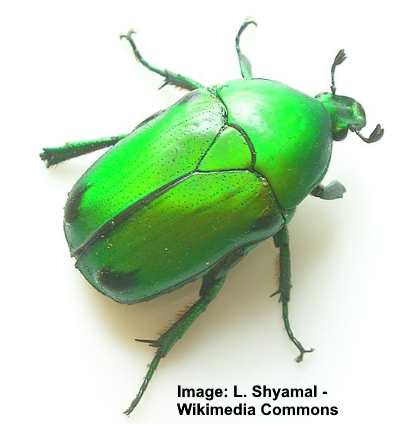
The big green scarab beetle has a shiny body with triangular marking on the back and small antennae
The green scarab beetle has a shiny emerald-green head, thorax, and wing cases. This large green beetle is the shape of a coffee bean and has a recognizable triangular marking on its back. The bright green coloration on the beetle’s elytra appears to have a reddish tinge at some angles.
Heterorrhina elegans green scarab beetles measure 0.78” to 1.18” (20 – 30 mm) long and have a glossy sheen. Close-up pictures of the beetles show their shiny green elytra are smooth without any pitting. It has clubbed antennae and six green legs with small spines. These green beetles are common in southern India.
Green beetle identification
The green scarab beetle is a shiny green beetle with an oval body, small antennae, and a pair of wing covers.
Mint Leaf Beetle (Chrysolina herbacea)
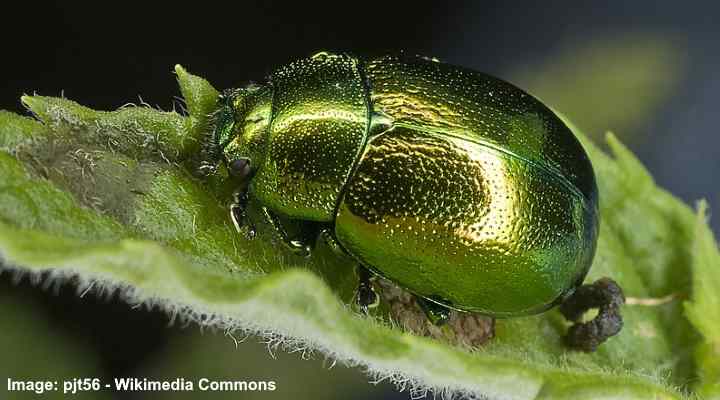
The small mint leaf beetle has a pitted metallic green body with a gold shine
The mint leaf beetle is a type of leaf beetle that is easy to spot due to its brilliant metallic green and gold wing cases, head, and thorax. Depending on the species, the beetle’s coloration could look coppery, purple, blue, or red. Its shiny back has lines of pits, and the green insect has metallic gold and green legs and segmented antennae.
The mint leaf beetle measures 0.25” to 0.39” (6.5 – 10 mm). You’ll often find the small metallic green beetle feeding on mint plants in wet or marshy places. In addition, the beetle is also found on other herbs like basil, thyme, and catmint.
Green beetle identification
The mint leaf beetle is a brilliantly-colored green beetle with an almost reflective sheen to its green and coppery body.
False Oil Beetle (Oedemera nobilis)
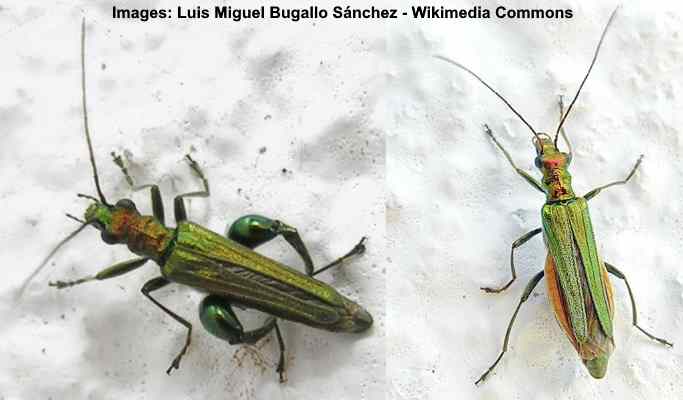
False oil beetle: male (left) and female (right)
The metallic green false oil beetle is a type of pollinating beetle with an elongated narrow body, slender shiny green head and thorax, and two long antennae. A distinctive feature of this skinny green beetle is its tapered wing covers which reveal some of the wings.
Most false oil beetles have a metallic green color, but some have a golden or coppery shine. The slender, glossy green beetles measure 0.23” to 0.43” (6 – 11 mm) long. The beetles are often found on flowers, where they act as beneficial pollinators.
Both the male and female false oil beetles look similar apart from one feature — their hind legs. Also called the thick-legged flower beetle, the male species has swollen hind legs, making them instantly recognizable.
Green beetle identification
Also called the swollen-thighed beetle, the green false oil beetle is a shiny metallic insect with a golden coppery sheen.
Rose Chafer Beetle (Cetonia aurata)
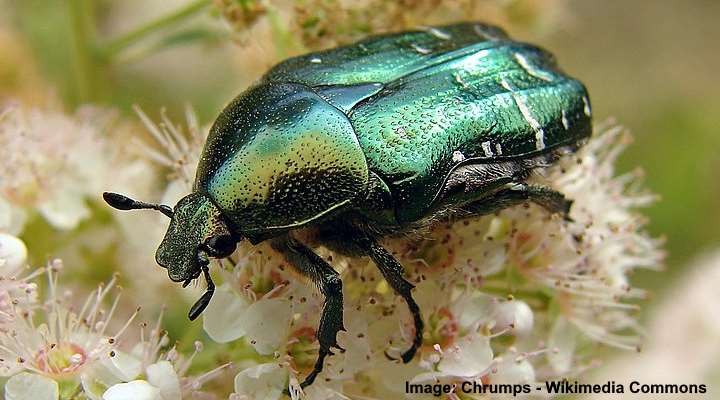
The metallic green rose chafer beetle has a V-shaped marking on the back with creamy white lines and short antennae
The rose chafer beetle is identified by its metallic green copper-colored wings with whitish-creamy markings on them. In addition, this shiny green beetle has short, clubbed antennae, green spiny legs, and a relatively small, square-shaped head. The green rose chafer beetle measures 0.66” to 0.78” (17 – 20 mm) long.
Rose chafer beetles are active during the summer and fall, where you’ll find them in woodlands and grasslands feeding on flowers.
Green beetle identification
The rose chafer beetle has identifiable thin white markings on a deep green metallic body.
Pale Green Weevil Beetle (Polydrusus impressifrons)
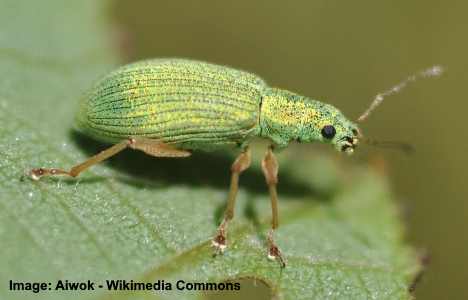
The pale green weevil beetle has a ridged body with large black eyes
The pale green weevil is a green type of beetle with a slender oblong body, large black eyes, and brown legs. It is also identified by linear ridges on its elytra, and two thin, long antennae.
The pale green weevil is a small green beetle that grows 0.27” (7 mm) long. You’ll find the insects feeding on tree foliage in spring and summer. However, the damage the beetles cause is insignificant.
Green beetle identification
The pale green weevil is identified by its longitudinal ridges on its light colored green wing cases and its brown legs.
Golden Ground Beetle (Carabus auratus)
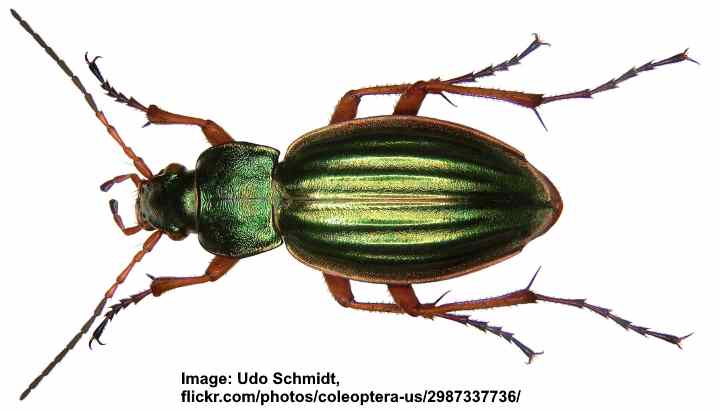
The golden ground beetle has iridescent green elongated body with long brownish legs and antennae
The golden ground beetle is a brightly-colored iridescent shiny green beetle with coppery margins on its ridged wing cases. The large green beetle has long legs in relation to its metallic, oval body and square thorax. In contrast to the bright green color, the golden ground beetle has orangey-brown legs.
The golden ground beetle measures between 0.66” to 0.86” (17 – 20 mm) long and feeds on common garden pests like snails and the Colorado potato beetle.
Green beetle identification
The golden ground beetle has a bright green metallic oval to tear-shaped body with orange-brown legs, mandibles, and antennae.
Green Dock Beetle (Gastrophysa viridula)
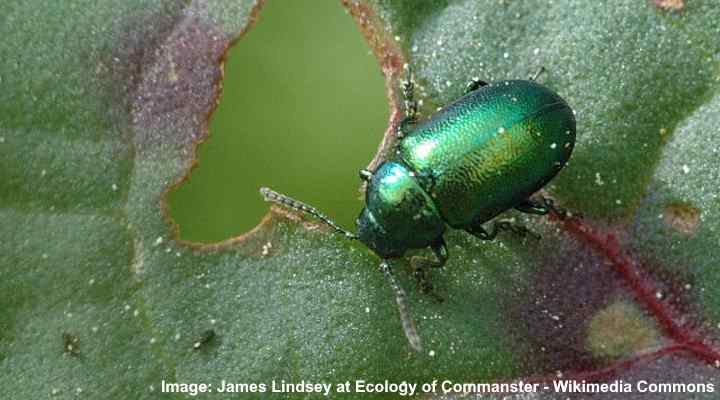
The small green dock beetle has a rounded shiny green body and is commonly found in Britain
The green dock beetle is a small type of green leaf beetle with a rounded metallic green body, serrated antennae, and shimmering green legs. Some pictures of this tiny beetle show its green body gives off a shiny golden sheen. However, the iridescent wing cases can appear blue, red, violet, or purple, depending on the light.
Female green dock beetle measures 0.27” (7 mm) long, with the males being significantly smaller. The beetle’s name comes from its preference for feeding on dock leaves, and it also goes by the name green sorrel beetle.
Green beetle identification
The small rounded green dock beetle has a shimmering metallic green body and pale green antennae.
Green Tortoise Beetle (Cassida viridis)
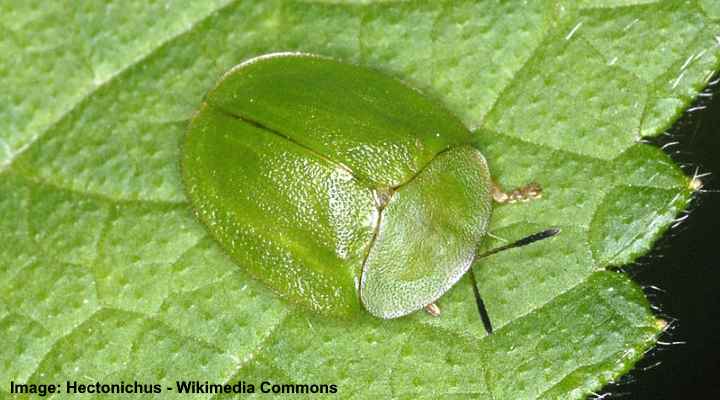
You can easily identify the green tortoise beetle by its flat and rounded lime-green body with short legs and antennae
The green tortoise beetle is a type of leaf beetle with an unusually flattened oval body and lime-green color. This almost round beetle has short feet, thread-like antennae, and a black underside. Looking up close, pictures of this strange-looking beetle show punctuations on its wing cases. A difference between the green tortoise beetle and others in the species is that it lacks any particular markings.
The green tortoise beetle measures 0.31” to 0.39” (8 – 10 mm), and its body appears round. The common name of tortoise beetles comes from their habit of acting like a tortoise when threatened. They retract their feet and antennae and hunker down on the plant leaves.
Green beetle identification
The green tortoise beetle is easy to identify due to its lime-green round body, tiny feet and antennae, and black underside.
Green Protea Beetle (Trichostetha fascicularis)
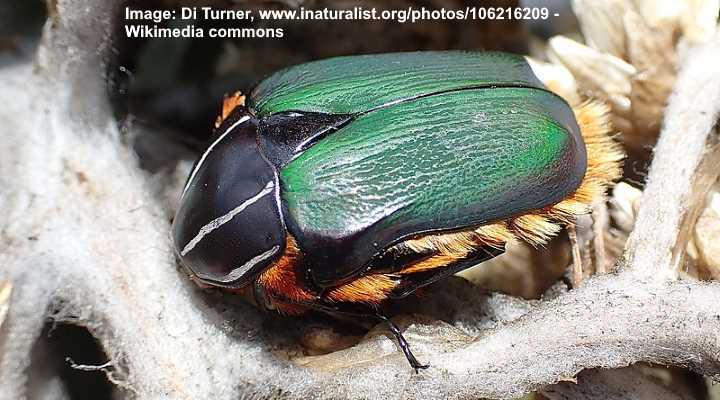
The green protea beetle has a black head with whitish lines and tufts of orange hairs around its body
The green protea beetle is a metallic green scarab beetle that feeds on various types of fruit. It’s straightforward to identify green protea beetle due to its black head, thorax, and triangular shape between the top of its wing cases. In addition, you will notice two whitish stripes on its thorax.
The green protea beetle measures 1” (25 mm) long and has a distinctively oval body. The shiny emerald-green wing cases have ridges, distinctive punctures, and tufts of orange hairs surrounding them.
Green beetle identification
The easy-to-identify protea beetle has a shiny dark green body, black head and thorax, and orangey tufts of hair around its body.
Related articles:
- Small Brown Beetles (In the House and Outside)
- Black Beetles – Identification
- Types of Red Beetles – Identification Guide
